No More Data Gatekeepers: How We’re Making Analytics Accessible to Everyone
In the modern enterprise, we’re told that data is our most valuable asset. But for many, it remains locked away, accessible only to a select few. The process is all too familiar: a question arises about a campaign, a ticket is filed, and days—or even weeks—later, a report arrives. By then, the opportunity to act may have already passed.
This delay, this friction between question and answer, is a major bottleneck to agility and growth. What if we could remove it entirely?
What if anyone in the organization, from the CMO to a media planner, could get immediate answers from complex datasets simply by asking a question?
This is the vision behind our new platform: AMI - Adaptive Media Intelligence. We’re not just building another dashboard; we’re fundamentally changing the relationship between people and data.
1. Start a Conversation with Your Data
Imagine your CMO is heading into a meeting and needs to know the top-performing channels from last week. Instead of a frantic call to the data team, they can simply open AMI Chat and ask:
“Which channels delivered the most impressions and had the highest spend last week?”
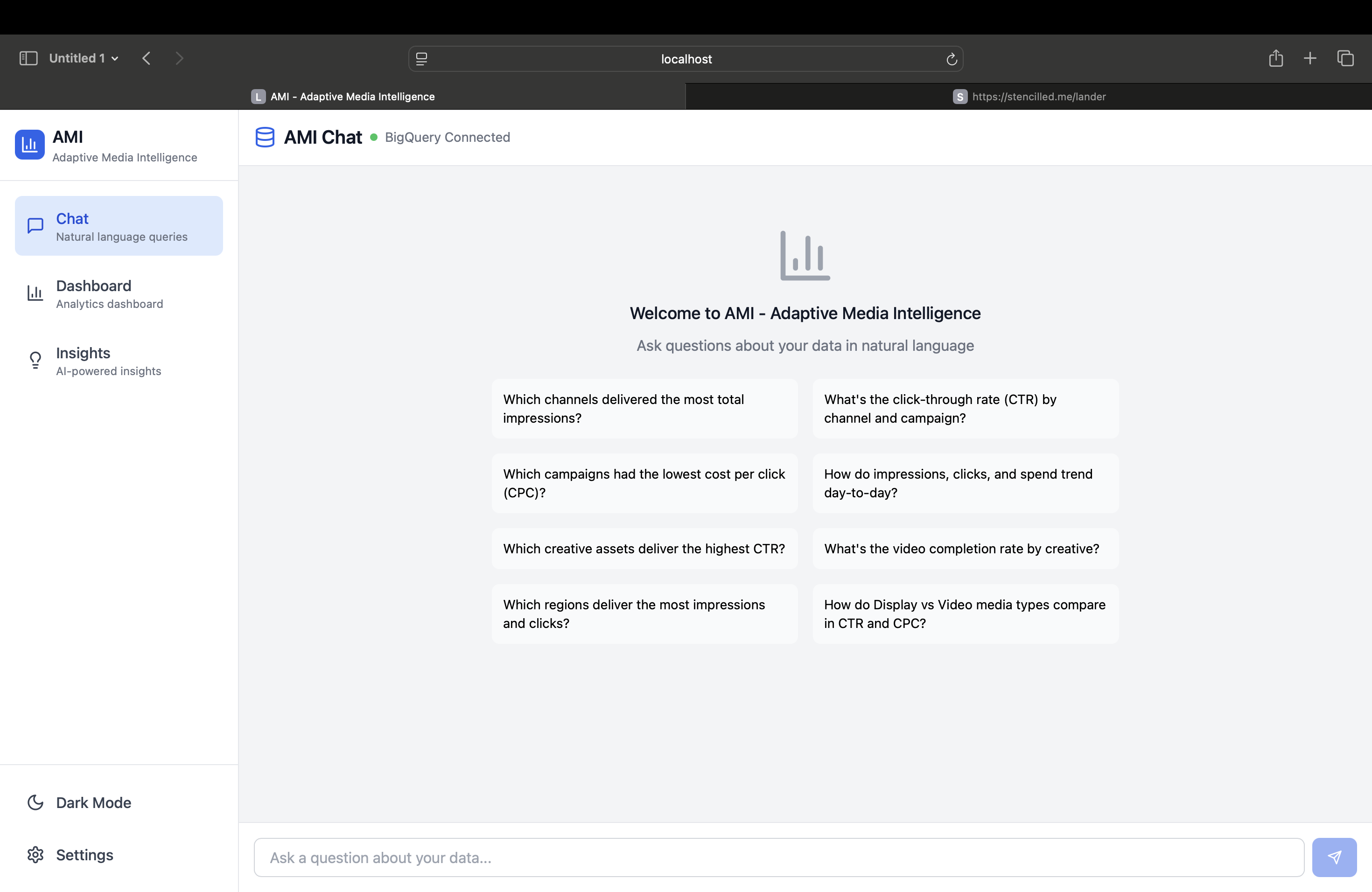
In seconds, they get a clear, natural language answer, backed by the exact data they need. No SQL, no waiting, no friction. This is conversational analytics. It empowers every user to query complex data on their own terms, fostering curiosity and enabling rapid, informed decisions.
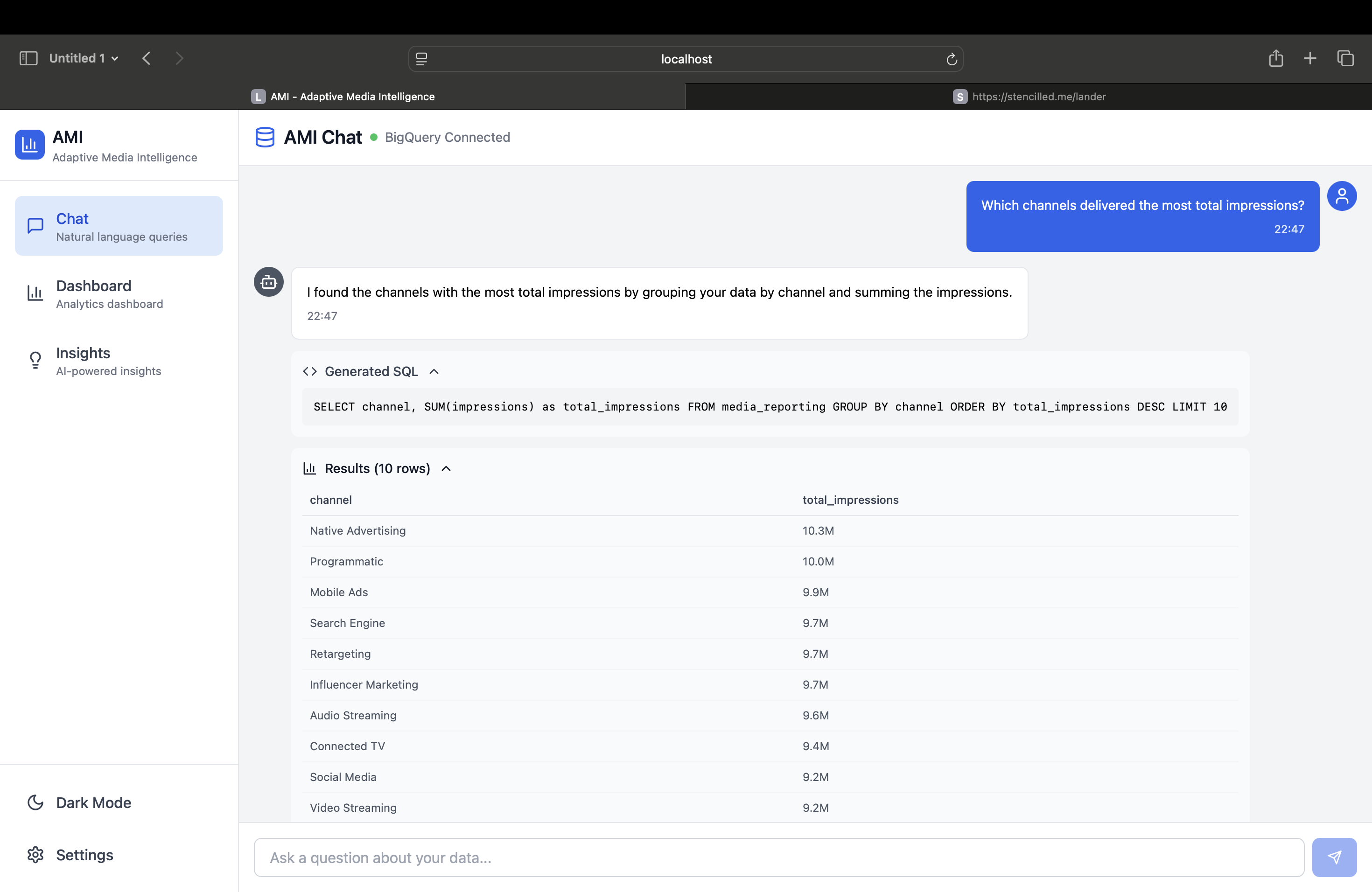
2. Deep Dive on Demand with Interactive Dashboards
Sometimes, a quick answer isn’t enough. You need to explore, to see the bigger picture, and to understand the “why” behind the numbers. For that, we have the AMI Dashboard.
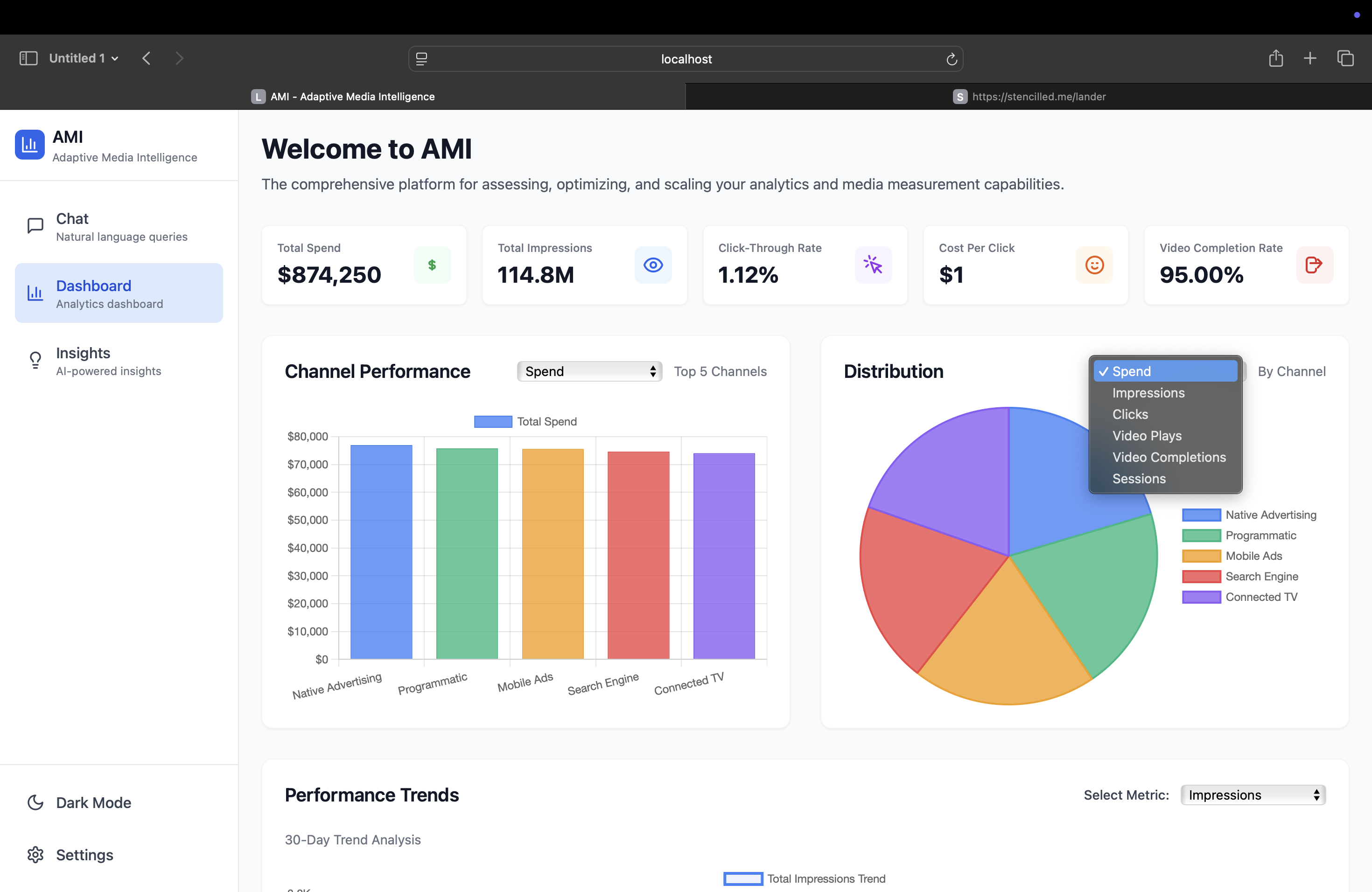
The dashboard provides a 360-degree view of all your media activities. It’s designed for exploration. With a single click, a media planner can pivot from a channel performance view to a geographic breakdown, or analyze which audience segments are responding best to a particular creative. This isn’t a static report; it’s a dynamic, interactive environment for discovery.
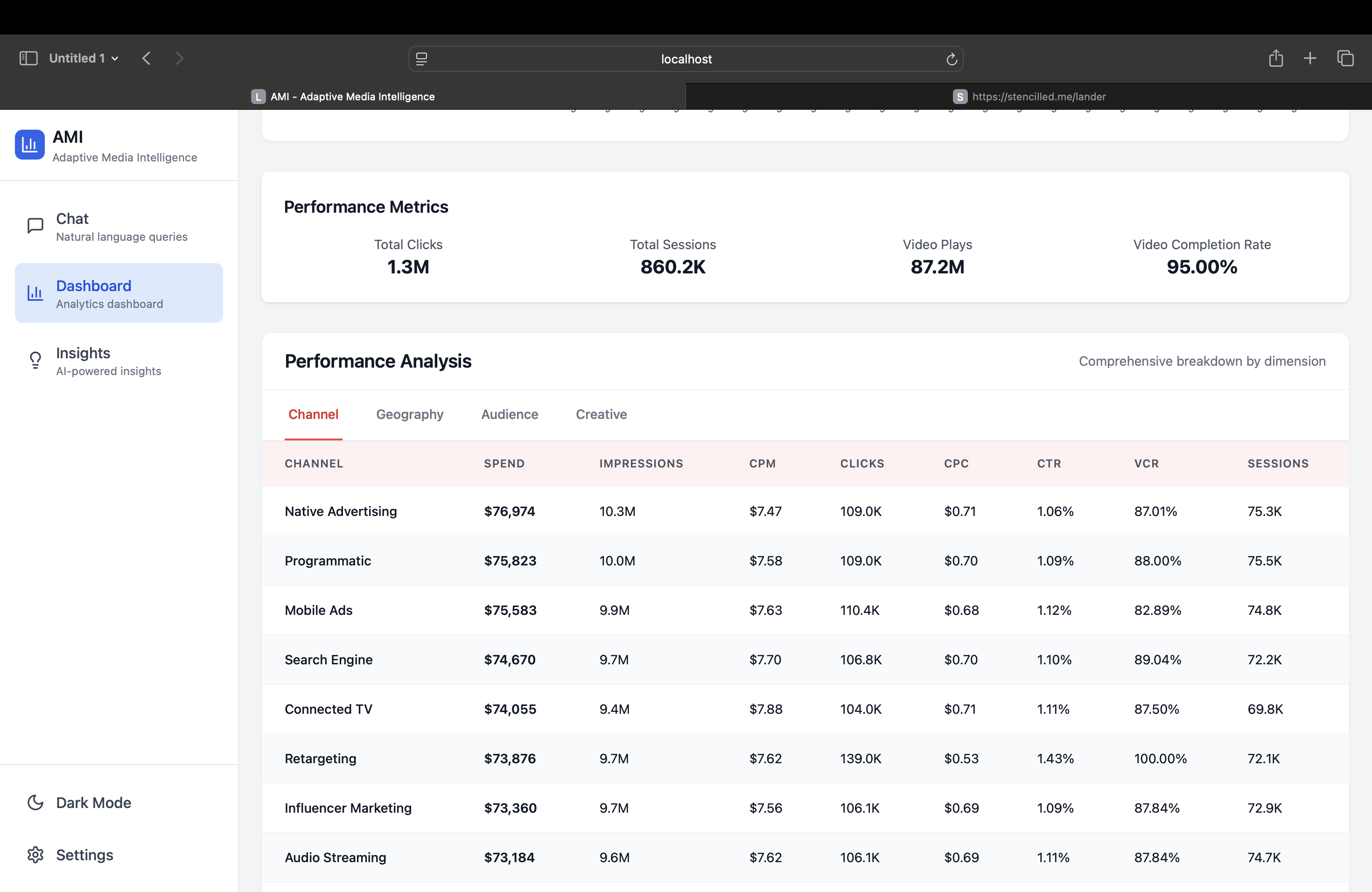
3. Go from Data to Decisions with AI-Powered Insights
The final step is turning data into action. This is often the hardest part. What do all these numbers actually mean? What should we do next?
That’s where the AMI Intelligence Hub comes in.
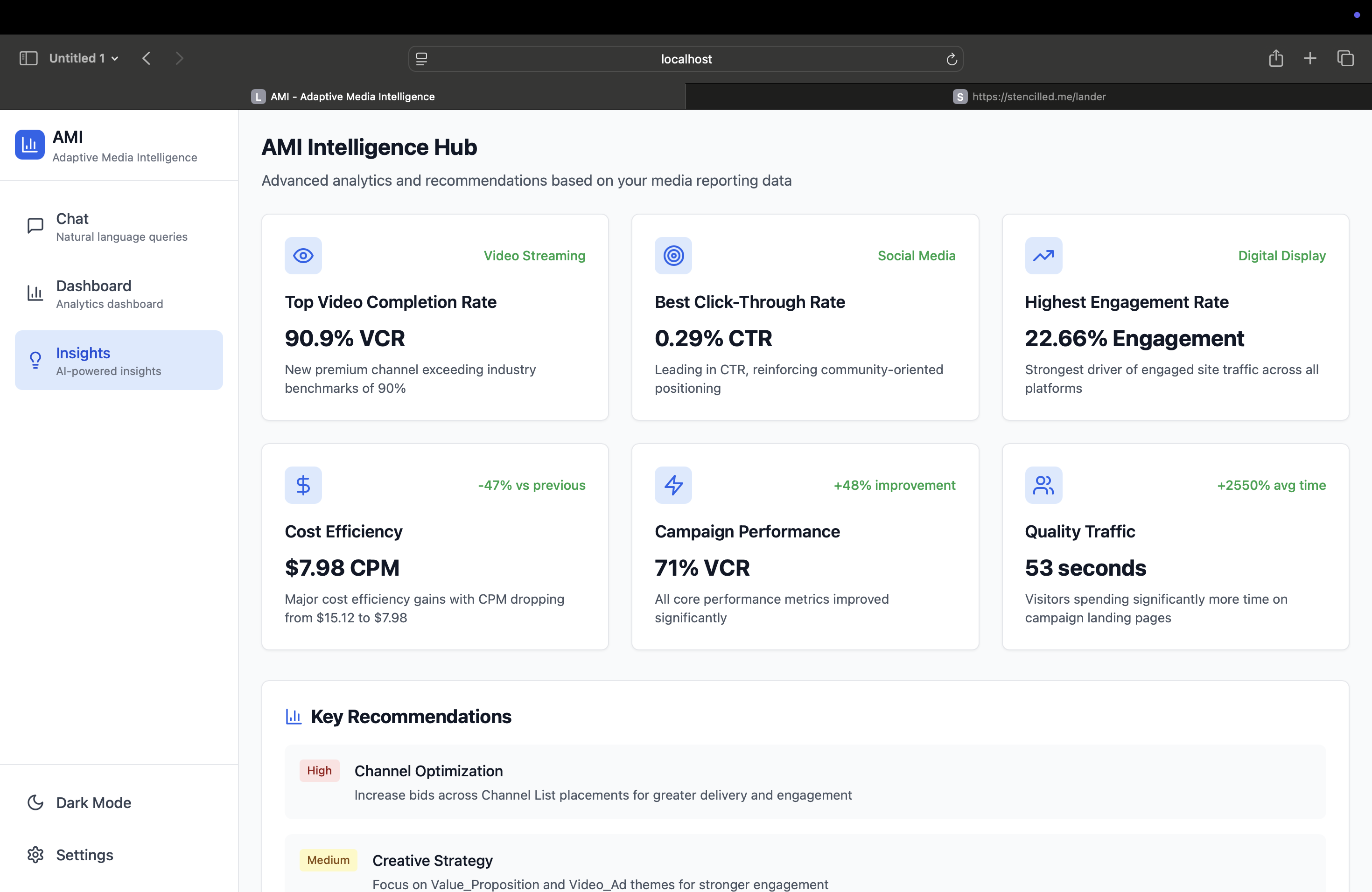
The Insights Hub is more than just analytics; it’s an AI-powered strategic partner. It automatically analyzes your data to identify trends, surface critical findings, and provide clear, actionable recommendations. It might suggest reallocating budget to an underutilized channel, or highlight a creative that is performing exceptionally well with a specific audience.
This moves your team beyond just reporting on what happened, to strategically planning what to do next, ensuring every decision is backed by data.
The Future is Accessible
By combining conversational chat, interactive dashboards, and AI-powered insights, AMI creates a seamless ecosystem for data exploration and decision-making. We are breaking down the silos and empowering every member of the organization to engage with data directly.
When data is truly democratized, it stops being a resource for a few and becomes the engine of growth for everyone.
🛠️ How AMI Was Built: The Technical Journey
Working in marketing data, I’ve seen firsthand how better decisions come when insights are easy to access. For this project, I leveraged Cursor’s AI-powered editor to translate plain-language prompts into queries and tables, seamlessly connecting to any data source. Paired with Vibe Code’s prebuilt components, I quickly assembled interactive dashboards and workflows.
OpenAI Integration: The Brain Behind the Interface
At the core of AMI’s conversational capabilities is OpenAI’s GPT-4, which powers:
Natural Language Query Processing
# Example: Converting "Which channels delivered the most impressions?"
# into structured SQL queries
def process_natural_language_query(user_question, schema_context):
prompt = f"""
Given this database schema: {schema_context}
Convert this question to SQL: {user_question}
Return only the SQL query.
"""
response = openai.ChatCompletion.create(
model="gpt-4",
messages=[{"role": "user", "content": prompt}]
)
return response.choices[0].message.content
Dynamic SQL Generation
- Automatically generates optimized SQL based on user questions
- Handles complex joins, aggregations, and filtering
- Provides explanations of the generated queries
- Suggests follow-up questions based on results
Intelligent Insights Generation
- Analyzes query results to identify patterns and anomalies
- Generates actionable recommendations
- Provides context-aware explanations of metrics
Universal Data Warehouse Connectivity
AMI is designed to connect to any data warehouse through a flexible connector architecture:
Supported Data Sources:
- BigQuery (currently connected)
- Snowflake
- Redshift
- Databricks
- PostgreSQL
- MySQL
- Custom APIs
Connection Architecture:
class DataWarehouseConnector:
def __init__(self, warehouse_type, connection_config):
self.connector = self._get_connector(warehouse_type)
self.config = connection_config
def execute_query(self, sql_query):
return self.connector.execute(sql_query)
def get_schema(self):
return self.connector.get_schema()
def test_connection(self):
return self.connector.test_connection()
Benefits of Universal Connectivity:
- No Vendor Lock-in: Switch between data warehouses seamlessly
- Unified Interface: Same conversational experience regardless of backend
- Scalable Architecture: Add new data sources without code changes
- Performance Optimization: Leverage native warehouse capabilities
The Cursor Development Workflow
Phase 1: Understanding Requirements
- Used Cursor’s AI to analyze business requirements
- Generated initial architecture diagrams and data models
- Created user stories and acceptance criteria
Phase 2: Rapid Prototyping
- Built the conversational interface in hours, not days
- Generated boilerplate code for database connections
- Created the dashboard layout with AI assistance
Phase 3: Iterative Development
- Used AI to refactor code as requirements evolved
- Generated test cases automatically
- Optimized performance with AI-suggested improvements
Phase 4: Integration & Deployment
- AI helped with deployment scripts and configuration
- Generated documentation and API specifications
- Created monitoring and logging implementations
Key Technical Features
1. Conversational Query Engine
- Natural language processing with context awareness
- SQL generation with error handling and optimization
- Query result formatting and visualization
2. Real-time Data Processing
- Live connections to data warehouses
- Caching layer for performance optimization
- Incremental data refresh capabilities
3. Interactive Dashboard Framework
- Responsive design with real-time updates
- Customizable widgets and charts
- Drill-down and filtering capabilities
4. AI-Powered Insights Engine
- Pattern recognition in data
- Anomaly detection
- Predictive analytics capabilities
The Future of AI-Assisted Development
This project demonstrates how Cursor and AI are transforming software development:
Accelerated Development Cycles
- What used to take months now takes weeks
- Complex features can be prototyped in hours
- Rapid iteration and testing cycles
Improved Code Quality
- AI-assisted code review and optimization
- Automated testing and documentation
- Consistent coding patterns and standards
Enhanced Collaboration
- AI helps bridge technical and non-technical stakeholders
- Clearer communication of requirements
- Faster onboarding of new team members
Democratized Development
- Non-technical users can contribute to technical discussions
- Business requirements translate directly to code
- Reduced dependency on specialized developers
Getting Started with Your Own AI-Powered Project
1. Define Clear Requirements
- Use AI to help clarify and structure requirements
- Create detailed user stories and acceptance criteria
- Identify key technical constraints and dependencies
2. Choose the Right AI Tools
- Cursor for code generation and development
- OpenAI for natural language processing
- GitHub Copilot for additional coding assistance
3. Start with Prototypes
- Build quick prototypes to validate concepts
- Use AI to generate initial code structures
- Iterate rapidly based on feedback
4. Focus on Integration
- Ensure AI components work seamlessly together
- Build robust error handling and fallbacks
- Create comprehensive testing strategies
5. Scale Gradually
- Start with core features and expand
- Monitor performance and user feedback
- Continuously optimize and improve
AMI represents the future of data analytics - where understanding your data is as simple as having a conversation. Built with cutting-edge AI tools and designed for universal compatibility, it’s not just a dashboard; it’s your organization’s data intelligence partner.
Ready to democratize your data? The future of analytics is conversational, intelligent, and accessible to everyone.